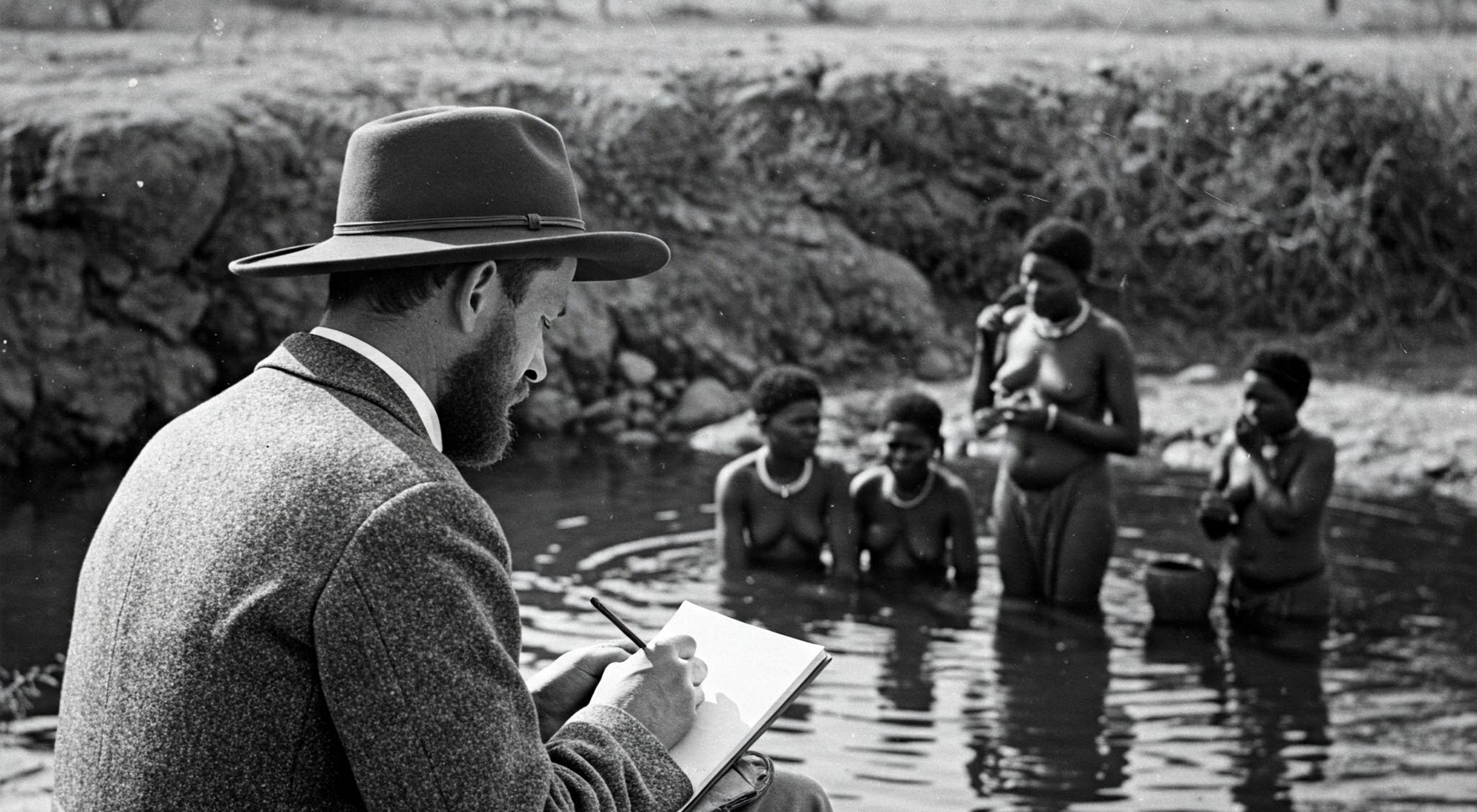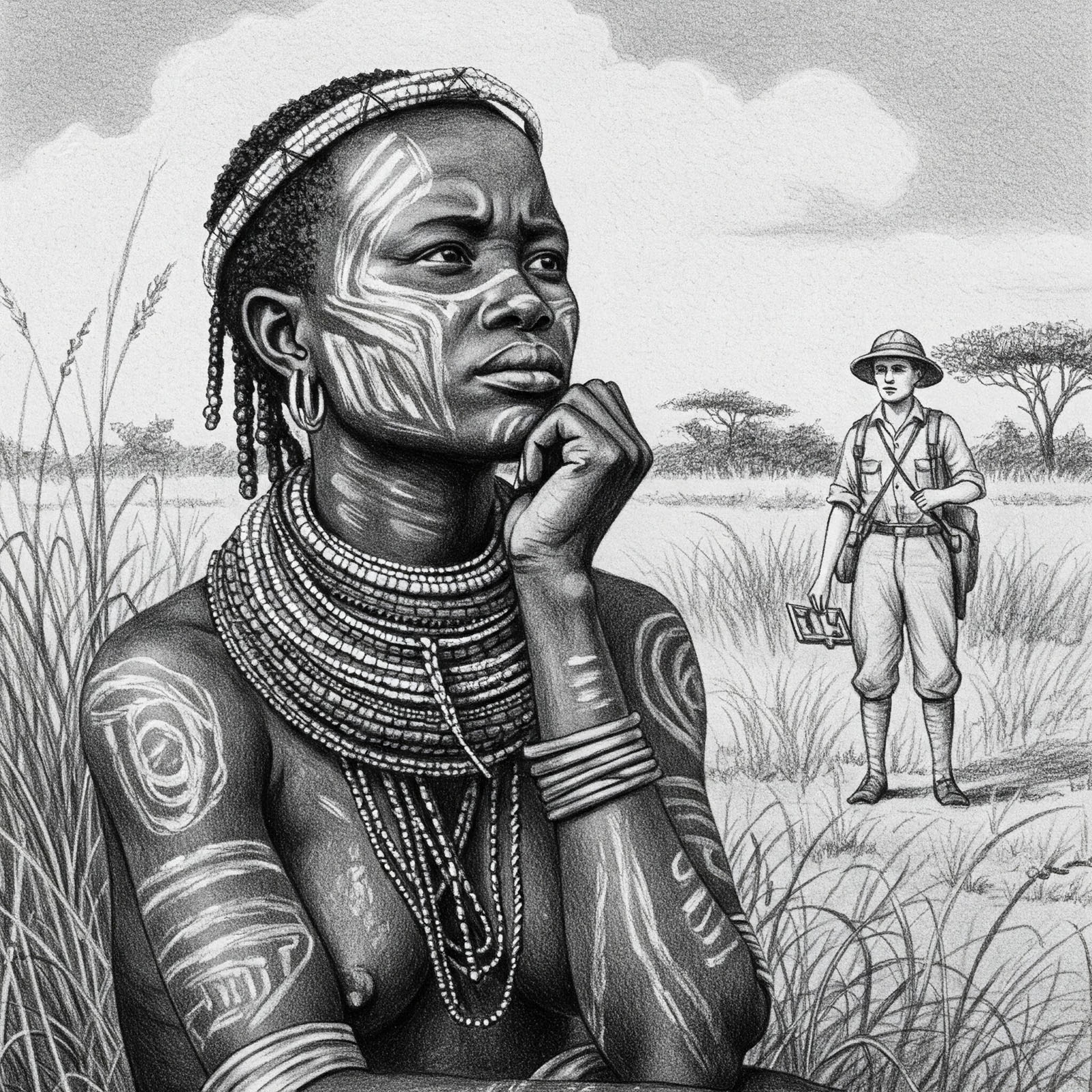The Ancient Tradition of Labia Stretching

European Explorer Observing Khoisan Woman Bathing Near Village
A European explorer records observations as Khoisan women bathes near her village.
Ancient Wisdom, Intimate Rite
The Ancient Tradition of Labia Stretching: A Historical and Cultural Exploration
In the farthest reaches of the world’s oral traditions, body modification has long served as a language of identity, belonging, beauty, and transformation. Among these practices is labia stretching, a form of genital elongation practiced by women across generations in parts of Africa and beyond. Though often hidden from global discourse, it holds profound cultural meaning and historical roots that stretch centuries into the past.
Unearthing the Origins: A Precolonial Ritual
Labia stretching is believed to have originated in sub-Saharan Africa, with some of the earliest known references emerging from oral traditions of the Bantu-speaking peoples, including the Baganda, Basoga, and Banyankole tribes of Uganda, and the Tonga and Lozi of Zambia and Zimbabwe. These groups practiced the ritual as part of a girl’s initiation into womanhood—a transition marked not just by physical changes but by social transformation.
While hard archaeological evidence is limited—owing to the personal and private nature of the practice—anthropologists and ethnographers began documenting it in the late 19th and early 20th centuries, often during colonial-era fieldwork. Early reports by British and German colonial officers and missionaries, though often dismissive or sensationalized, inadvertently preserved crucial data about these customs.
In Buganda (modern Uganda), for instance, ethnographers recorded how girls as young as eight were taught by their grandmothers or elder women to begin slowly stretching their labia minora. The practice was gradual, spanning several years, and accompanied by songs, dances, and stories meant to bind the girls to their lineage and feminine identity.
Symbolism and Meaning in Ancient Contexts
In traditional societies, labia stretching was not simply about the body. It was part of a cosmology of womanhood—tied to fertility, maturity, beauty, sexual pleasure, and spiritual readiness for marriage.
-
Fertility & Marriage: In many communities, elongated labia were seen as a sign of sexual preparedness and fertility. A woman with well-developed labia was believed to be more pleasing to her husband and more capable of sexual fulfillment, which in turn was connected to childbearing success.
-
Cultural Identity: For tribes such as the Tonga of southern Zambia, the ritual was seen as a cultural marker, distinguishing Tonga women from neighboring tribes. It served as a rite of passage and a way to transmit cultural values intergenerationally.
-
Aesthetic Standards: In contrast to Western ideals of tight, concealed genitalia, many African societies prized the visibility and length of the labia minora. They were considered beautiful and symbolic of maturity, much like stretched necks, lip plates, or scarification among other groups.
Timelines and Transmission: Oral Histories and Colonial Interference
Though pinpointing an exact origin date is difficult, anthropological estimates suggest that labia stretching has existed for over 500 years, perhaps even much longer. Without written documentation from the precolonial era, the practice survived and evolved through oral storytelling, maternal mentorship, and communal rituals.
The colonial period brought disruptions. Western missionaries and medical authorities, bound by Eurocentric ideals, often condemned labia stretching as primitive or unnatural. In response, some communities internalized this stigma, while others quietly preserved the practice in private spaces—away from public scrutiny. In this way, labia stretching became an act of resistance and cultural preservation, surviving waves of cultural erasure.
A Pan-African Phenomenon
While labia stretching is most documented in East and Southern Africa, scattered evidence points to similar practices in Central Africa and parts of the Sahel. Each region had its own methods, timelines, and beliefs:
-
Uganda (Baganda and Basoga tribes): Girls started stretching before puberty, often between 8–12 years old, guided by older female relatives.
-
Zambia and Zimbabwe (Tonga, Lozi, Shona): The practice was incorporated into puberty initiation ceremonies and was considered crucial for marriage eligibility.
-
Rwanda and Burundi: Known as gukuna, labia stretching was practiced to enhance sexual pleasure for both partners and was often seen as a marital duty.
These regional differences point to a widespread tradition, adapted locally but grounded in shared themes of female agency, sexuality, and social development.
Comparative Practices in Other Cultures
While labia stretching is most known in Africa, body modifications involving the genitals exist across the globe:
-
Thailand and the Philippines: In some indigenous groups, vaginal stretching using bamboo or fingers was reported, though less formalized.
-
Amazon tribes: Practices like genital tattooing or piercing carried similar symbolic and aesthetic meanings.
-
Ancient Egypt and Nubia: While not directly tied to labia stretching, the reverence for the vulva as a divine source of life was prevalent, as seen in fertility rituals and goddess worship.
These parallels suggest that the genitals have long served as symbolic landscapes—sites of both individual expression and collective ritual.
Modern Revivals and the Quest for Reclamation
In recent decades, there has been a growing interest in reclaiming traditional practices through a feminist and decolonial lens. Some African women now speak openly about labia stretching as a source of empowerment, countering narratives that frame it purely as oppression or mutilation.
Additionally, diaspora communities have sparked renewed dialogue around the practice—questioning whether and how such traditions should be preserved, adapted, or redefined in a modern context.
Critics worry about coercion or early-age indoctrination, especially when consent is murky. Advocates, meanwhile, emphasize education, autonomy, and choice—calling for respectful understanding rather than cultural condemnation.
Ancient Yet Evolving
Labia stretching is a rich, multifaceted tradition—not easily categorized as purely cultural, sexual, or aesthetic. It is a practice embedded in the lives of women who have navigated the tides of colonization, globalization, and cultural change.
From the lens of an explorer, the tradition is not a relic of the past but a living thread in the fabric of identity and female expression. In studying it, we are reminded that beauty, ritual, and sexuality are deeply cultural—and that understanding them requires curiosity, humility, and a refusal to judge the unfamiliar through narrow lenses.
As more women share their stories and scholars dig deeper into history, the practice of labia stretching continues to challenge our assumptions and enrich our understanding of the diversity of human experience.
"Passed from hand to hand, this quiet tradition shapes not just the body — but identity, intimacy, and belonging."
Open Discussions About Labia Stretching

An evocative illustration depicting a moment of early cross-cultural encounter: a Khoisan woman sits gracefully in a sunlit grass field, adorned in traditional attire, breast exposed and body paint, her hand thoughtfully placed under her chin as she gazes ahead. In the distance, a European explorer—dressed in period attire—stands observing her, highlighting the complex dynamic of curiosity, colonialism, and cultural presence during early expeditions into southern Africa.
Countries where Labia Stretching is practiced.
-
1.5333554,32.2166578
Uganda
-
-14.5189121,27.5589884
Zambia
-
-18.4554963,29.7468414
Zimbabwe
-
-1.9646631,30.0644358
Rwanda
-
-3.4264490,29.9324519
Burundi
-
-28.8166236,24.9916390
South Africa




